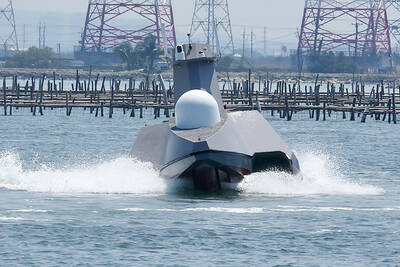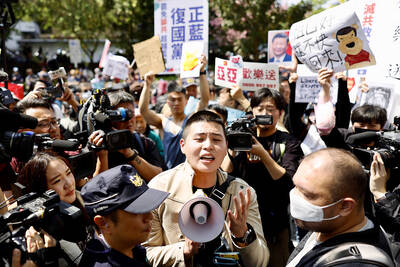Seven protesters who were injured during a crackdown on demonstrations against a Chinese envoy's visit to Taiwan earlier this month filed lawsuits alleging police brutality yesterday.
The seven who were involved in four cases of alleged police brutality showed medical documents, photographs and video recordings of their injuries and how they were injured during a news conference in front of National Taiwan Democracy Memorial Hall in Taipei before submitting their cases to Taipei District Court.
“I was talking with some friends on the sidewalk across a small street from a side entrance of the Grand Formosa Regent Taipei [on the night of Nov. 5],” said Huang Yi-ling (黃怡翎), one of the plaintiffs.
At the time, Association for Relations Across the Taiwan Strait Chairman Chen Yunlin (陳雲林), was at a dinner banquet hosted by Chinese Nationalist Party (KMT) Chairman Wu Poh-hsiung (吳伯雄) at the hotel.
As demonstrators surrounded the hotel, the guests were unable to leave until a little past 2am when some 2,000 police officers dispersed the crowd by force.
“When we got there at around 9:30pm, the area was still quiet. But about an hour later, a large number of police officers showed up,” Huang said. “One officer was saying something through a speaker from across the street, and we couldn't hear it very well, so we asked ‘are you talking to us?’”
The police did not answer, and the next thing Huang and her friends knew, they were being pushed back by officers using their shields, she said.
“It was quite strange, because the officers didn't push us away, instead they pushed us against the wall and started beating us with their batons,” Huang said, adding that she and her friends kept pleading for the officers to stop and yelling that there was no way out behind them, “but they continued for quite some time.”
Another plaintiff, Ted Chiang (江一德), said he turned his back to the riot police who were trying to disperse the crowd in front of the hotel, hoping to stop further physical clashes.
However, a video clip showed that he was pulled behind the police line.
“After I got pulled in, I fell on the ground, and the police officers hit me with batons and shields,” Chiang said.
“I just wanted to run away from the madness, but an officer hit my head with his baton, then I started bleeding all over,” he said, holding up a T-shirt with bloodstains and holes that he wore that night.
“To this day, I still feel dizzy and am still taking medicine,” he said.
Lin Feng-jeng (林峰正), executive director of the Judicial Reform Foundation, who helped organize a panel of attorneys to provide assistance to the victims of alleged police brutality, said: “It's very disappointing that the police have only looked into cases in which officers were attacked and tried to find out who attacked them while turning a blind eye to cases in which innocent citizens were wounded.”
“While [President] Ma Ying-jeou [馬英九] has constantly said that the ‘the problem [with demonstrations] is the violence,’ I would like to remind him that there is also the problem of police violence,” he said.
At a separate setting yesterday, Democratic Progressive Party (DPP) Taipei City Councilor Chou Wei-you (周威佑) accused the Taipei City Police Department of framing him — and possibly other protesters — by putting him on a list of violent protesters during Chen's visit.
The department issued a booklet of photos of 66 “violent protesters” on Wednesday and called on the public to help the police in identifying suspects who allegedly took part in the demonstrations.
The photo of Chou, who was allegedly punched in the left eye by an officer while he was protesting against Chen in front of the hotel, was in the booklet put together by the police on Wednesday morning, but the department removed his photo yesterday after the councilor challenged its inclusion.
“If the police department believes I am a suspect, then it is covering me by removing my photo. If not, did the department include my photo by mistake?” Chou said.
Chou later showed a video clip of the incident in front of the hotel that night to prove that he did not attack the police and that he was punched by an officer in the eye while trying to separate the police and protesters.
He and other DPP Taipei City councilors condemned the department's Songshan Precinct for lying about what happened that night by arguing that Chou was hit by a bottle of water, rather than by an officer, in its news release.
In response, Lee Wen-chang (李文章), deputy chief of the department's Criminal Investigation Division, said that the police hurt Chou by accident, adding that Chou's photo was included in the booklet by mistake because “the staff member who handled the booklet did not know it was Councilor Chou.”
Calling in question the department's handling of the aftermath of the protests, Chou urged Taipei Mayor Hau Lung-bin (郝龍斌) to look into the department's conduct.
“How many suspects in the booklet are innocent and treated unjustly like me? Such poor handling of the incident is a serious breach of human rights,” Chou said.
Putting handcuffs on his own hands, Chou said he refused to enjoy any privilege as a councilor and vowed to file a lawsuit against the police department.
DPP Taipei City Councilor Liu Yao-ren (劉耀仁) urged the public to provide evidence, such as photographs or videotapes showing police taking part in violence against the protesters and to file lawsuits against the police.

ENDEAVOR MANTA: The ship is programmed to automatically return to its designated home port and would self-destruct if seized by another party The Endeavor Manta, Taiwan’s first military-specification uncrewed surface vehicle (USV) tailor-made to operate in the Taiwan Strait in a bid to bolster the nation’s asymmetric combat capabilities made its first appearance at Kaohsiung’s Singda Harbor yesterday. Taking inspiration from Ukraine’s navy, which is using USVs to force Russia’s Black Sea fleet to take shelter within its own ports, CSBC Taiwan (台灣國際造船) established a research and development unit on USVs last year, CSBC chairman Huang Cheng-hung (黃正弘) said. With the exception of the satellite guidance system and the outboard motors — which were purchased from foreign companies that were not affiliated with Chinese-funded

PERMIT REVOKED: The influencer at a news conference said the National Immigration Agency was infringing on human rights and persecuting Chinese spouses Chinese influencer “Yaya in Taiwan” (亞亞在台灣) yesterday evening voluntarily left Taiwan, despite saying yesterday morning that she had “no intention” of leaving after her residence permit was revoked over her comments on Taiwan being “unified” with China by military force. The Ministry of the Interior yesterday had said that it could forcibly deport the influencer at midnight, but was considering taking a more flexible approach and beginning procedures this morning. The influencer, whose given name is Liu Zhenya (劉振亞), departed on a 8:45pm flight from Taipei International Airport (Songshan airport) to Fuzhou, China. Liu held a news conference at the airport at 7pm,

AIR SUPPORT: The Ministry of National Defense thanked the US for the delivery, adding that it was an indicator of the White House’s commitment to the Taiwan Relations Act Deputy Minister of National Defense Po Horng-huei (柏鴻輝) and Representative to the US Alexander Yui on Friday attended a delivery ceremony for the first of Taiwan’s long-awaited 66 F-16C/D Block 70 jets at a Lockheed Martin Corp factory in Greenville, South Carolina. “We are so proud to be the global home of the F-16 and to support Taiwan’s air defense capabilities,” US Representative William Timmons wrote on X, alongside a photograph of Taiwanese and US officials at the event. The F-16C/D Block 70 jets Taiwan ordered have the same capabilities as aircraft that had been upgraded to F-16Vs. The batch of Lockheed Martin

GRIDLOCK: The National Fire Agency’s Special Search and Rescue team is on standby to travel to the countries to help out with the rescue effort A powerful earthquake rocked Myanmar and neighboring Thailand yesterday, killing at least three people in Bangkok and burying dozens when a high-rise building under construction collapsed. Footage shared on social media from Myanmar’s second-largest city showed widespread destruction, raising fears that many were trapped under the rubble or killed. The magnitude 7.7 earthquake, with an epicenter near Mandalay in Myanmar, struck at midday and was followed by a strong magnitude 6.4 aftershock. The extent of death, injury and destruction — especially in Myanmar, which is embroiled in a civil war and where information is tightly controlled at the best of times —